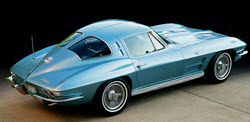1963 Corvette Stingray

The 1963 Corvette Sting Ray was the beginning of the second generation Corvettes, the C2. The chassis engineering as well as the body style had undergone remarkable changes compared to the 1962 Corvette. The new style was described as “aggressive, yet never brutal” and the new designed created supreme aerodynamic properties. The changes of the chassis were equally dramatic. The 1963 Corvette Sting Ray did for instance offer independent rear suspension, which greatly increased the driving experience.
The 1963 Corvette Sting Ray was the result of successful collaboration between Bill Mitchell, Larry Shinoda and Zora Arkus-Duntov. It borrowed a lot of ideas from Mitchell’s 1959 Stingray racer, as well as from the1961 Mako Shark. Mitchell and Shinoda created two versions of the 1963 Corvette Sting Ray: the coupe and the convertible. Both variants were shown to the media and car enthusiasts in June 1962. They received a lot of attention, because the new sleek style of the 1963 Corvette Sting Ray differed from all other sports cars. The 1963 Corvette Sting Ray was nearly 3 inches lower than the previous Corvette, as well as 3 ½ inches more narrow and 2 inches shorter.
The 1963 Corvette Sting Ray featured independent rear suspension designed by Zora Arkus-Duntov. All the earlier Corvettes had been equipped with a live rear axle that formed the main part of the rear suspension. This type of solution is straightforward and economical, but far from ideal during high performance handling since it is heavy and less capable on rough surfaces. The independent rear suspension of the new Corvette Sting Ray was instead based on three links and a single multi-leaf transverse spring.
One of the many notable features of the 1963 Corvette Sting Ray is the split rear window. This design was discontinued in 1964, due to safety reasons. Bill Mitchell was very fond of the split rare window, since he felt that it completed the “stinger” lines of the car. Today, the split window corvettes are much more expensive than Corvettes with ordinary rare windows.
Space travel and aeronautics was the height of fashion in 1963, and this can be clearly seen in the red interior of the 1963 Corvette Sting Ray. The design was based on airplane cockpits rather than automobiles, and the driver is much separated from the passenger. 1963 was the year when drivers could enjoy air condition in their Corvette for the first time, provided of course that they were willing to pay an additional $422. AM-FM radio was another option for those who could afford it.
The power of the 1963 Corvette Sting Ray was at 365 hp (272 kW). The car had phoney hood vents, but they were discontinued within a year since they were unnecessary made the design a bit busy. Another 1963 feature was the so called power steering. The sleek style of the 1963 Corvette Sting Ray naturally called for sleek details, such as the hide-away headlights. In the 1960’s, head lights were big and interfered with the aerodynamics of cars. It would take until 2005 before exposed headlights were once again seen on a Corvette.



